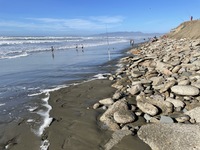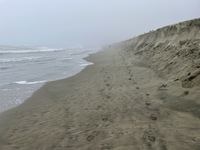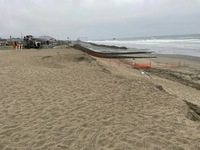 |
| Angelika/Mike Schilli |
|
Michael Our city beach on the Pacific side is quite famous and notorious. At the so-called "Ocean Beach," anyone can walk for miles for free and enjoy the breathtaking views. Hikers can see all sorts of marine life, such as albatrosses, dolphins, seals, or whales. The beach stretches endlessly, from San Francisco's now-closed Cliff House in the north down to the suburb of Daly City. During winter storms, 30 foot high monster waves break off the coast, which even the most daring surfers avoid. On warm summer days, walkers only hear the splashing, and strollers enjoy fabulous sunsets. We walk there a few times a month and have surely covered a thousand miles by now.
However, the cold and treacherous ocean claims a few reckless individuals every year, who, often intoxicated, venture too close to the water and are then grabbed and dragged in by sudden "sneaker waves." Without a wetsuit, it's "game over" after just a few minutes due to the cold water, as the muscles fail, and even those who are otherwise good swimmers sink and drown. I've surfed there before, but I must say that I would only recommend it to beginners when there are baby waves, and the enormous current, which pulls you towards the bay or sweeps you south depending on the time of day, requires good paddling technique on the board, a well-trained back musculature, and nerves of steel.
The beach borders the waterfront road "Great Highway," the fortification of which, as previously reported (Rundbrief 08/2012), partially consists of old tombstones from the former city cemetery of San Francisco. Over the years, however, the ocean has gradually claimed more and more sand from the beach, causing city officials to fear that it might also erode the street fortifications. Without delay, they initiated a construction project that used a barge anchored in the ocean to pump sand onto the beach, where it was then piled up with heavy construction machinery (Figure 1).
Said and done! After several months of construction, there is now a six to eight feet high layer of sand between the ocean waves crashing onto the beach and the reinforcement of the coastal road. However, what the builders apparently overlooked is that when the tide comes in, a very narrow death zone is created between the sand wall and the water for walkers, from which there is no easy escape, as no one can climb a sand wall. We recently went for a walk there at three-quarters tide and almost got wet from the waves creeping up. I predict that it will get dangerous at high tide. Hopefully, the rescue personnel stationed further north will intervene in time in case of an emergency.















